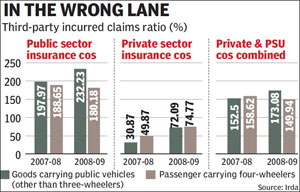New Delhi: It will be at least a year or two before life insurers plan to tap the primary market. They would rather work towards improving valuations since dramatic regulatory changes in the last one year have significantly hit their bottomline.
The regulatory changes have resulted in sharply lower business margins for unit-linked insurance plans and forced insurers to cut commission payouts. This has impacted the product and distribution strategy of life insurers and adversely affected their profitability forcing them to pare their operating expenses.
Amitabh Chaudhry, MD & CEO, HDFC Life says, “We are not in a hurry to go for an IPO. Our shareholders are very clear that we would go for it only at the right time which implies the right valuation that can be sustained based on our business performance.”
Last year, HDFC Standard Life and Reliance Life had evinced interest in raising funds through IPOs as and when the regulator finalised the guidelines for public issues.
The IRDA chairman J Hari Narayan had on Monday said these guidelines would be issued by April end. The life insurance industry has been saddled with high operating losses. According to a Boston Consulting Group report, the cumulative losses for private life insurers are in excess of Rs 16,000 crore in the past one decade with almost 75-80 per cent capital being used for funding operating losses rather than solvency requirement.
Rajesh Sud, CEO & MD, Max New York Life Insurance says, “The life insurance industry is currently going through the process of adapting their business model to suit the new environment created mainly due to change in regulations. Many private life insurance companies that started operations around a decade back are turning profitable. This is a time to consolidate to ensure a sustainable profitable growth. FDI is of critical importance to the sector at this juncture.”
There are 22 private life insurers in India besides state-owned LIC. The insurance regulator is likely to allow only those insurers in operation for at least 10 years with a track record of three successive years of profit to go public. Of the 22 insurers, 10 which have foreign joint venture partners, complete a decade of operation this year.
While ICICI Prudential Life, Kotak Mahindra Life, SBI Life, Met Life, Bajaj Allianz Life, Sahara India Life and Aegon Religare Life have reported profits, just five of them complete a decade of operations in India.
Industry sources said instead of IPOs, life insurers would prefer diluting their stake in favour of their foreign joint venture partners, if the FDI limit is hiked to 49 per cent from current 26 per cent.
G Murlidhar, COO, Kotak Mahindra Old Mutual Life says, “A rather tepid two years on account of global slowdown and regulatory changes in the sector has seen companies focusing on rationalisation and consolidation rather than growth. It will take at least a year for the situation to stabilise and for growth to return to the previous heady levels.”
With large investors like Warren Buffett having expressed interest in buying stake in one of the insurance companies once the FDI in insurance is hiked to 49 per cent, it is more likely that life insurers would explore the FDI route to raise capital rather than going public.
